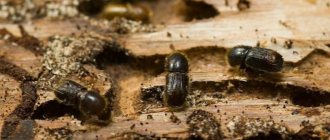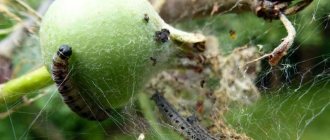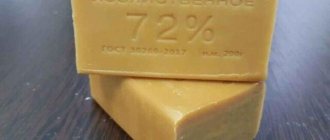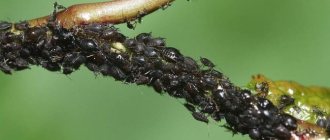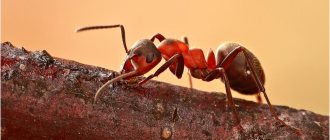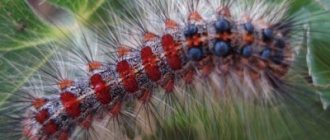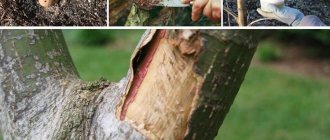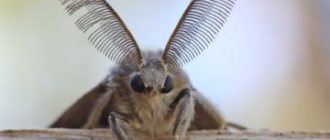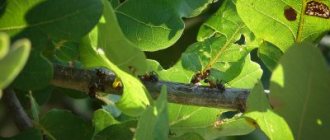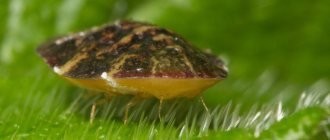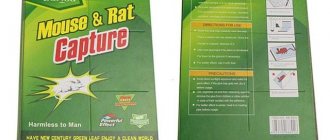10941
The damage that aphids cause to an area is not comparable to the miniature size of the insect. In order to prevent mass infection, it is necessary to follow all the rules of agricultural technology and not forget about prevention. Before fighting aphids on fruit trees, in order to prevent the formation of colonies and avoid epidemics in the garden, it is necessary to find out the reasons for the appearance of insects, and then select chemical and biological preparations, and folk remedies.
Green aphid attack
What kind of aphid is it and why is it dangerous?
Aphids are a frequent visitor to plots. This insect usually does not exceed 0.5 mm in length, which makes it difficult to detect early in the lesion. There are species reaching 7 mm. Gardeners notice aphids when their colonies become larger. First, a small black dot appears on the inside of the leaf. There the insect creates colonies.
Some species have wings to help them migrate. When treated with pesticides and other drugs, aphids fly from place to place in search of more suitable conditions. Wingless species also move around the site with the help of short legs, but within the nearest fruit crops.
The insect likes not only fruit trees and shrubs, but also vegetables, flowers, and ornamental plantings. For normal life, insects need moisture. With the help of a proboscis, aphids pierce the soft tissues of leaves and buds, thereby receiving nutrients. Due to the regular loss of amino acids, parts of the plant become depleted over time and stop developing.
Pest colonies on foliage
Signs of harmful activity of a pest colony:
- leaves fall prematurely;
- the edge of the leaf blade curls and darkens;
- plant shoots are deformed;
- growths appear on the trunk;
- the buds fall;
- the plant loses its ovaries;
- the overall growth of a tree or shrub slows down;
- the plant becomes so weak that it is no longer able to survive the winter cold.
Signs of pests
Aphids have a round or oval shape. The parasite is from 1 to 5 mm in length. Small individuals can be less than a millimeter. Particularly large – up to 8 mm. Aphids come in several colors depending on the species: green, red, pink, black, yellow, and also transparent.
It is quite simple to understand that pests have appeared on plants. This is signaled by:
- dried and curled leaves;
- tree trunks and branches are covered with mucus;
- deformed shoots;
- weakened flower stems;
- fallen buds.
Aphids can be seen with the naked eye. The insect moves in colonies, so the infected area will have several dozen parasites at the same time. Pests prefer to settle on the leaves from the inside. They can also be found on the top of plants.
How dangerous is a garden guest?
The pest leaves waste products on the leaf blades - secretions from carbohydrates and excess water. The sugary substance is called honeydew. It covers the leaf blade, preventing normal photosynthesis. The leaves become a target for the fungus. In addition, a colony with aphids is a carrier of viral diseases. As a result, severe damage is caused to the plant.
Spraying as a control method
To remove aphids, a whole range of agrotechnical measures is required. Among them are competent crop care, preventive measures and the direct phased destruction of colonies using chemical, biological and folk methods.
Timing for treating plants against aphids
The named guest operates in dachas throughout the entire season, from early spring to autumn frosts. Before deciding when you can spray fruit crops, you need to remember that not only chemicals are effective, but also biological products and folk remedies. The first treatment against aphids is carried out at the moment of bud break, the second - during flowering and formation of ovaries, the third - at the beginning of fruiting, the fourth - after harvesting.
Biological products that are developed on the basis of living microorganisms can be used throughout the growing season. This group includes Fitoverm, Lepidotsid, Vostok EM, Fitosporin, Mikosan and others. Almost all biological products not only fight pests, but also help strengthen the immune system of plants.
A set of preparations to help the gardener
Treatment with chemicals is carried out at any time, but at least 2-4 weeks before harvest, and even better before the ovaries appear. Anti-aphid chemicals are appropriate for massive infestations of fruit trees.
Processing method
The most common treatment method is spraying from a sprayer. Any solution should be at room temperature and filtered through cheesecloth or a fine sieve. Do not exceed the consumption rate of the working solution or make the tincture more saturated. The aphids will die faster, but burns on the leaves and stems will not be the best consequence of the treatment. This method is suitable for killing aphids on leaves and shoots.
No less dangerous are aphids, which can infect plant roots. It is much more difficult to detect; wilting of leaves and stems may be the first sign of the appearance of this particular pest. When this variety appears, watering should be used. For fruit crops, you need to choose solutions without substances that are toxic to humans or burn.
There are many chemicals that can completely get rid of aphids, but not all of them are safe. Folk remedies are often not inferior to them in effectiveness. Let's look at the most accessible and effective ways to kill aphids.
Chemicals against aphids
To get rid of aphids, no special knowledge is required, since most drugs are equally effective against all types of pests. All work should be carried out wearing protective gloves and a mask. You must follow the instructions strictly, since if the concentration of the drug is exceeded, a burn may appear on the crown. After contact with the treated plant, it is recommended to wash your hands. The effect of chemistry lasts on average 3-4 weeks.
The most effective insecticides:
- Kalash is a new spraying product to which aphids have no immunity. It is based on the potent substance imidacloprid. Available in 10 ml containers and 5-10 liter canisters. It lasts for 3 weeks, is not washed off by rain, and does not evaporate in the sun. It has a low consumption rate and can be used together with fungicides and herbicides.
- Tanker - the action of the insecticide lasts throughout the season. Destroys aphids on fruit plantings, flowers, and vegetable crops. It has a detrimental effect on many pests of fruit plants.
- Spark double effect is a product for comprehensive protection of plantings from invasion by more than 60 species of garden inhabitants. Includes 2 powerful insecticides - permethrin and cypermethrin. The composition includes a special potassium fertilizer to restore damaged areas of plants. Available in tablets weighing 10 g. Recommended for severe infection before bud break.
Instructions for use - Aktara is a popular insecticide against a variety of pests with an active substance called thiamethoxam. The properties of the solution are maintained for 15-30 days, depending on weather conditions. The prepared composition can be used within 48 hours. Available in the form of emulsion, powder, tablets, small granules.
- Actellik gives the best results in warm and humid conditions, although treatment is not recommended at temperatures above +28°C. Do not mix with Bordeaux mixture and other alkaline agents. In case of a massive pest invasion, it is recommended to double the dosage.
Bordeaux liquid for aphids
Bordeaux mixture consists of lime and copper sulfate. The drug often helps gardeners in cases of infection by insects and fungi. Fruit plants are treated with the solution several times:
- The first treatment is before the buds swell.
- The second is a 3% solution at the time of bud opening.
- The third - at the vegetative stage, 1% solution.
A properly prepared solution should have a light blue color, a slightly alkaline pH reaction, and no sediment. It is not recommended to use laundry soap for stickiness, as it will shift the pH value. Frequent use of the product is prohibited so as not to lead to an excess of copper salts in the soil.
Basic composition of 1% solution:
- bucket of water 10 l;
- quicklime - no more than 110 g;
- copper sulfate – 100 g.
Preparation of a 1% solution of Bordeaux mixture
To make a 3% solution, you need to increase the proportions. You will need 300 g of copper sulfate, 450 g of lime and 10 liters of water. In the orchard, a 3% solution is used for rich blue spraying. To determine the reaction of a liquid, use red litmus paper pre-moistened in water. If it turns slightly blue, then everything is done correctly.
Spraying in hot weather or after rain leads to foliage burns.
It is not recommended to mix Bordeaux mixture with any drug.
Instructions for using Bordeaux mixture
The best intestinal remedies
Intestinal agents enter the digestive system of pests, poisoning the insects. They act more slowly than contact ones, but have a low risk of re-infection.
5 Actellik
Aktellik
Actellik is sold in large containers for processing large vegetable gardens and summer cottages. The drug effectively protects agricultural crops and flowers. It is often used for processing warehouses and grain stocks. The formula adheres well to an inert surface and lasts for several weeks. A nice bonus is the short waiting period between spraying and harvesting. The composition does not penetrate into vegetables and fruits and does not remain in the soil.
Reviews say that Actellik is compatible with most insecticides and fungicides. However, it is advised to check each case. The drug has the best effect at the initial stage, one course consists of 2 sprays with a difference of 5-7 days. Then you can forget about aphids for several seasons. Buyers warn of a strong chemical smell that makes them dizzy. Because of this, it is not suitable for treating residential premises. The product is sold in large containers, not everyone needs that much.
4 Chlorophos
Chlorophos
Chlorophos is the most famous drug from this group; it paralyzes aphids. A few hours later she dies. The formula is absorbed through the intestines and mucous membranes. It comes in powder form and is mixed in water. Due to the harsh chemicals in the composition, precautions must be taken. The stage of development of the parasites does not matter; the formula is effective against larvae and adults. The concentration depends on the severity of the problem; Chlorophos copes with any frequency of infection.
Reviews warn of inconvenient application. For example, to treat a currant bush, you will have to brush each leaf. The advantages include rapid destruction, effectiveness against all types of aphids, resistance to high temperatures and precipitation. However, the formula is extremely harmful; it is recommended to leave the area for several hours after treatment. Chlorophos lasts for 2-3 days, modern preparations protect longer.
3 Karbofos
Karbofos
Karbofos has the widest spectrum of action, covering most known pests. The active substance is an organophosphorus compound, used to treat vegetable gardens. The basis is the toxic component malathion, it quickly kills pests. The manufacturer recommends carefully treating trees; the formula only works on areas completely covered with the composition. The drug is very resistant to sunlight, rain, and wind.
It is highly recommended not to spray Karbofos at home; it has a rather pungent, chemical smell. There are reviews online from users who ventilated the room for several months. When used regularly against aphids, it becomes addictive. This can be avoided by treating pests with a mixture of several products. Karbofos does not affect parasite eggs; it is not created for prevention. The drug is recommended for the most severe lesions; one course consists of 3 sprays.
2 Fufanon-nova
Fufanon-nova
Most of Fufanon nova is talathion, which covers the stems and foliage, protecting it from pests. The substance remains in the air for some time, scaring off unwanted neighbors. The drug kills all insects that eat grass and bark. However, the formula is very susceptible to rain and quickly breaks down into simple particles. On the other hand, low aggressiveness makes it the safest for vegetables, animals and children. Protection lasts from 10 days, pests die after a few days.
Buyers are advised to combine Fufanon-nova with more chemical drugs to combat serious infections. They talk about effective getting rid of aphids. Many are pleased with the low price and availability in most stores. The solution is prepared simply; any bottle is suitable for spraying. The course is just one spray.
1 Biotlin
Biotlin
Biotlin surpasses its competitors in terms of duration of action. It is based on the substance imadacloprid, which has acaricidal and insecticidal properties. It enters the pest’s body, paralyzing the respiratory tract and digestive tract. The aphid dies within a few hours. The drug is the best for a complex effect on adults, larvae and eggs. Parasites that migrate from other trees die within a few days. Then they are shaken off the leaves by wind and rain.
The product is most effective due to the lack of addiction in insects. Biotlin can be alternated with other chemicals. However, mixing it is not recommended. The result lasts up to 3 weeks, during which time aphid eggs are eliminated. A nice bonus is getting rid of the ants; they lose their main source of food. Spraying currant leaves and other bushes is carried out in calm weather in the morning or evening.
Biological products to protect plant health
Organic-based products can protect the site no less effectively than chemical products. At the same time, biological preparations are harmless to humans and plants. The following biological products are trusted by gardeners:
- Arrow is a powder that simultaneously eliminates aphids and feeds the plant. To prepare the solution, take 50 g of powder and 10 liters of water. The effect is noticeable already on the third day after treatment.
- Fufanon is a fast-acting organophosphorus emulsion. Paralysis of the insect occurs after 2 hours, and within a day the pest dies. Sold in ampoules from 1.5 to 10 ml. It is not recommended to mix with other pest control products. To spray the crowns of trees and shrubs, you need to dissolve 10 ml in a bucket of water. To process a small bush, 1.5 liters are required. It should be sprayed before flowering; in case of severe infection, the procedure is repeated 2-3 times.
- Fitoverm for plants is a product in ampoules and bottles from which a solution for spraying is prepared. The dosage depends on the degree of spread of the pest and on average is 5 ml of the substance per 0.6 liter of water. After treatment, the effect of Fitoverm lasts for three weeks.
Fitoverm in ampoule
When working with biological products, it should be taken into account that rain reduces their effectiveness. It is recommended to repeat the treatment the next day after a rainstorm. If the weather is dry, spraying is carried out on the 12th day.
The best means of systemic action
Systemic drugs penetrate plants, making them poisonous to pests. They are suitable for processing bushes and tall trees, especially when a person cannot reach the top branches. The difference from competitors is fast absorption; the products are not afraid of rain. However, it takes several weeks to wait for the result.
5 Confidelin
Konfidelin
Confidelin quickly removes aphids from vegetables, flowers and other crops. It protects plants for 14 days and does not decompose when exposed to sunlight. The formula is resistant to humid air and does not wash off when watering. The composition is not phytotoxic and does not harm the environment. When dosed correctly, it is not dangerous to people, animals and good insects. Confideline is useful against most species of aphids. It is allowed to be mixed with other drugs.
Buyers note the rapid action of the product and the low risk of addiction. They say that plants get rid of the problem with the first spray. However, you need to work through each leaf, it takes a lot of solution. Maximum effectiveness occurs on day 3. The formula copes with any degree of infection, the effect varies depending on the concentration in the water. It has two active substances, so it affects a larger number of pests (compared to competitors).
4 Commander
Commander
The commander is aimed at getting rid of garden pests. The basis is the strong organic poison imidacloprid. It added 200 grams per liter. The drug comes in ampoules of different volumes; there are options for home plants and large gardens. It does not lose effectiveness even at very high temperatures. Quickly dissolves in water, turning into a stable suspension. Aphids do not get used to the formula; it lasts for several seasons. Low level of toxicity does not harm nature.
The Commander has the lowest consumption and an affordable price. The substance is resistant to washing off; one treatment is enough for the season. The formula is stored in the cells of trees and bushes for a month. Buyers call it most effective when applied early in the spring. For example, when the first leaves appear on roses. The result is visible after 3 days, at first it seems that there is no effect. However, the Commander cannot cope with large-scale infections alone.
3 Aktara
Aktara
Aktara is a neonicotinoid and affects the receptors of the nervous system. The main active ingredient thiamethoxam penetrates into plants, but practically does not affect the fruits. When watering bushes and trees, the formula takes up to 3 days to reach the top stems. Aktara is not afraid of high temperatures and does not lose effectiveness in the rain. Protection lasts up to a month in leaves and up to 60 days in soil. However, there is a risk of aphids becoming accustomed, which can lead to repeated infections. The drug only affects larvae; it is recommended to alternate it with other chemicals. It is compatible with most insecticides and fungicides.
Customers say the formula is harmful to bees and beneficial insects. Aktar should be sprayed in calm weather. The product is used up quickly, the ground must be wet. The plant is watered abundantly with the solution. You need to monitor the situation for a week; the aphids may return. It is not recommended to use Aktara near bodies of water.
2 Spark Gold protection
Spark Golden Protection
Spark Gold Protection is one of the latest developments based on imidacloprid. It is popular all over the world, tested on 140 crops. The formula protects against most annoying pests and their larvae. The best results were obtained on potatoes, currants, and ornamental crops. The product has a long-lasting effect, quickly absorbing into the leaves. The composition spreads throughout the above-ground part of the plant, lingering for a month. It helps against aphids that have adapted to other chemicals.
Buyers note excellent performance in hot weather, Iskra simplifies the care of plants in warm regions. It does not pose a danger to humans, animals, fish and beneficial insects. And the pests die from “nervous excitement”; the weakest ones fall off immediately. The formula is recommended for general use at any stage of infection. It is allowed to spray the product at home, but it is advisable to ventilate the room well.
1 Tanrek
Tanrek
Tanrek is effective against adult aphids and larvae. It is indicated when FOS and pyrethroids do not help. The product protects treated plants for several weeks. It is not afraid of high temperatures and rain. The best results are obtained on apple trees, roses and flower crops, currants, tomatoes and cucumbers. The formula penetrates into stems, leaves and roots. It blocks the nervous system, the aphid dies within 24 hours. The product is not as effective for prevention, only when mixed with other chemicals.
Buyers considered the main advantage to be a one-time use that destroys the entire population at once. The formula has an increased level of danger and has a bad effect on humans and animals. But it does not suppress plant growth or spoil the fruits. The product should not be used near bodies of water; it poisons fish. Spraying should be carried out in calm weather. For safety, it is recommended to use a respirator, protective clothing and goggles.
Insects and plants in the fight against aphids
Biological methods of control are considered one of the most effective. Once you place a ladybug on your property, it will immediately begin to absorb harmful guests. In just one day, one assistant will eat two hundred parasites.
Nurse insects that will help rid the area of an aphid colony:
- lacewings;
- flower flies;
- Red ants do not feed on aphids, but are enemies of black ants. This species is considered an ally of aphids; such insects are not afraid of fire, as they hide deep in the soil. Red ants will help destroy black ants.
Sparrows, tits, and linnets are biological weapons against pests. It is important to attract all these creatures to the site and not create situations that are dangerous for their existence. For example, many beneficial insects overwinter in fallen leaves and dry grass. Ladybugs will love corn tops. To burn it all means to deprive of helpers, to provide aphids with a poorly protected garden.
Video about the use of ammonia and laundry soap.
A powerful remedy against aphids is plants. It is worth planting henbane, tobacco, dandelion, basil, wormwood, garlic, onions, horseradish, cornflower, and shepherd's purse on the site. Petunia, begonia, nasturtium, the beloved mallow, bird cherry, and viburnum, on the contrary, attract aphids, so they should be planted as far as possible from fruit crops.
Aphids in the garden - how to fight?
Among all pests, aphids have a small, albeit dubious, advantage. It has a very fragile shell, which is destroyed even by ordinary soap solution. So you can even do without chemical insecticides.
— Rinse out all the beds that are possible with a hose;
— For greater efficiency, prepare a solution of liquid soap at the rate of a spoon per liter;
— Grind 100 g of tar soap into a bucket of water and use for spraying;
— Pass through a chopper or finely chop two cups of tomato leaves, potato tops or sorrel. Pour the mixture with a little more water, let it brew for several days and dilute it in a bucket for spraying;
— Prepare an infusion of 40 g of finely chopped onion per liter of water. Let the mixture sit overnight, add a little laundry soap and strain;
— Garlic infusion is prepared in the same way as onion infusion, but you need 250 g of garlic per liter of water. 50 ml of concentrate is enough per bucket of water for spraying, so it is also very economical;
- Mix crushed horseradish, hot pepper or any other hot ingredients with water and liquid soap;
— Plant marigolds near cucumber and bean beds for prevention, and tansy and pyrethrum along the perimeter of the garden. These plants contain substances that repel pests;
— Attract natural enemies of aphids to the garden - ground beetles, ladybugs and lacewings. Now you don’t even need to take special measures, because their larvae are specifically available in stores.
Photo: zen.yandex.ru
Diseases of currant leaves: descriptions with photos, treatment
Folk remedies for aphids on fruit trees
Infusions are preferred by those who want to grow the healthiest crop possible without chemicals. Many of them are no less effective than chemicals. Spraying with herbal infusions is the basis of folk methods of struggle.
Before you find out what to spray on leaves affected by aphids, you need to look at what herbs grow around the area. The basis is taken from those plants that insects cannot tolerate: tansy, horseradish, tobacco, wormwood.
Recipe for wormwood tincture:
- The stems are cut with a knife, poured with boiling water and left for a day.
- The contents are filtered and mixed with a solution of laundry soap (100 g). This will help the product stick to the leaf.
- The affected crown is sprayed with infusion, special attention is paid to the lower parts of the foliage.
- 5 liters of the drug is enough for one plant.
Solution obtained from green mass
Infusions are prepared similarly from tobacco leaves, chamomile stems and flowers, dandelion roots, onion peels, and potato tops. It's good if the plants have a pungent odor.
The fight against aphids on fruit trees is possible with the help of ash:
- 300 g of ash is dissolved in 10 liters of warm water. You can boil the mixture for half an hour.
- For stickiness, add 100 g of laundry soap, rubbed into fine shavings.
To treat the crown against aphids without spraying, they resort to fumigation. Wood chips are placed in a tin can and a fire is made from them. Tobacco dust is poured into the fire. As soon as smoke begins to pour out of the container, it is placed under the infected plant.
Video about using soda in the fight against aphids.
How to remove aphids from seedlings
Seedlings are very sensitive to all external factors, so aphids can completely destroy them. Young greenery withers before our eyes, the leaves curl and lose color.
— If there are very few aphids, remove them manually using gloves;
— Treat the seedlings with a solution of 30 g of laundry soap per liter of water;
— Add 100 g of tobacco powder to a liter of soap solution;
— Pour 200 g of pine needles with a liter of water, let it brew for a couple of days, dilute and use for rinsing;
— Use a solution with the addition of neem oil, an effective natural remedy against aphids. At the same time, this is an excellent prevention against thrips and ticks;
- 300 g of crushed chamomile, marigolds or dandelions, along with the roots, pour a liter of water and let it brew for 3 days;
— If the seedlings are in a greenhouse, then fumigation with tobacco smoke is ideal. Make a small fire from thin branches in a metal container and pour the contents of any cheap cigarettes into it.
Photo: sezon-ka.ru
Lavatera (50 photos): varieties, planting and care in open ground
Preventive measures
Protection against insects begins with prevention:
- Aphids lay eggs in the bark of trees. In the fall, all exfoliated parts must be removed. Autumn pruning of damaged and old shoots is carried out.
- In winter, dig up the soil around the bush, replacing the mulch layer.
- It is necessary to take measures to expel black ants, which co-exist with aphids, from the site. When digging up the soil, insects are poisoned. Antimol, formaldehyde will do.
- You can install a special sticky belt on the tree trunk. It will prevent ants from climbing up the trunk.
- In the spring, the tree trunk circle is dug up, and appropriate fertilizers are applied under the bush.
Aphids reproduce very quickly, and any indulgence can lead to the growth of parasite colonies. Only a set of all the listed measures guarantees the garden’s protection from pests.
Measures to prevent the appearance of aphids
And finally, you should pay attention to how to prevent aphids from appearing on plants. Maybe all this seems simple and elementary, but it is precisely such simple things that keep the garden clean.
- Carry out inspections in a timely manner so as not to miss the appearance of pests.
Aphid on a leaf.
- Pruning and removing weeds.
- Remove anthills from the area and monitor the spread of these animals in the plantings.
- In autumn, tidy up the area, remove growth and tops.
- Comply with crop rotation requirements and choose the right neighbors.
